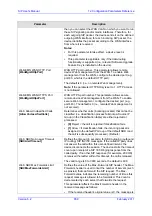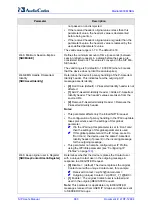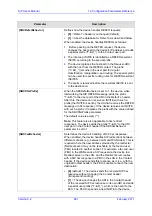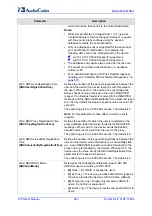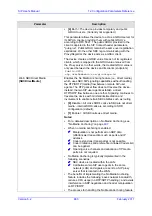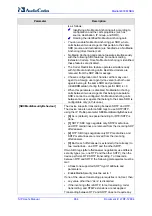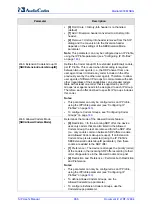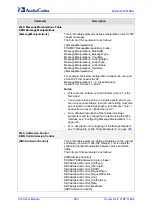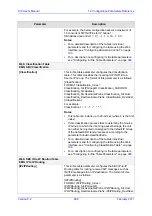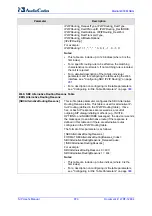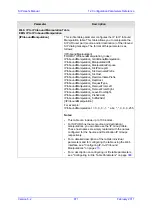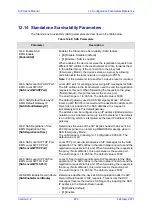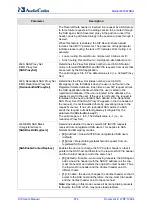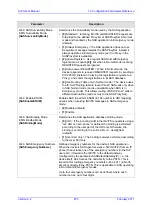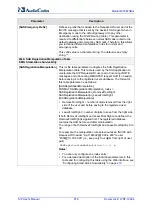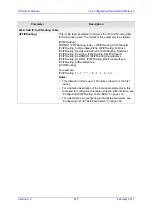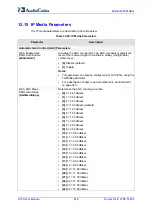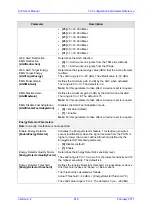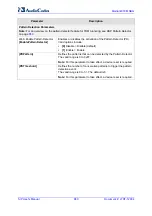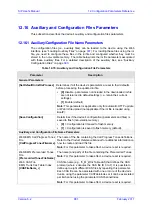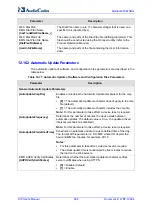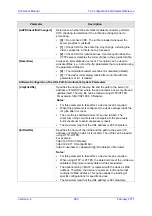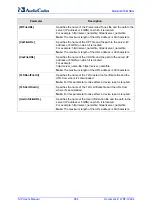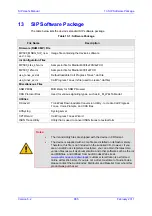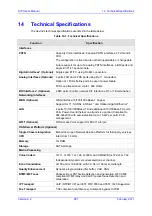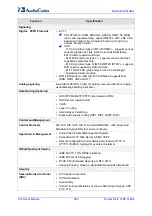
Version 6.2
873
February 2011
SIP User's Manual
12. Configuration Parameters Reference
12.14 Standalone Survivability Parameters
The Stand-alone Survivability (SAS) parameters are described in the table below.
Table
12-68: SAS Parameters
Parameter
Description
Web: Enable SAS
EMS: Enable
[EnableSAS]
Enables the Stand-Alone Survivability (SAS) feature.
[0]
Disable Disabled (default)
[1]
Enable = SAS is enabled
When enabled, the device receives the registration requests from
different SIP entities in the local network and then forwards them
to the defined proxy. If the connection to the proxy fails
('Emergency Mode'), the device serves as a proxy by allowing
calls internal to the local network or outgoing to PSTN.
Note:
For this parameter to take effect, a device reset is required.
Web: SAS Local SIP UDP Port
EMS: Local SIP UDP
[SASLocalSIPUDPPort]
Local UDP port for sending and receiving SIP messages for SAS.
The SIP entities in the local network need to send the registration
requests to this port. When forwarding the requests to the proxy
('Normal Mode'), this port serves as the source port.
The valid range is 1 to 65,534. The default value is 5080.
Web: SAS Default Gateway IP
EMS: Default Gateway IP
[SASDefaultGatewayIP]
The default gateway used in SAS 'Emergency Mode'. When an
incoming SIP INVITE is received and the destination Address-Of-
Record is not included in the SAS database, the request is
immediately sent to this default gateway.
The address can be configured as an IP address (dotted-decimal
notation) or as a domain name (up to 49 characters). The default
is a null string, which is interpreted as the local IP address of the
gateway.
Web: SAS Registration Time
EMS: Registration Time
[SASRegistrationTime]
Determines the value of the SIP Expires header that is sent in a
200 OK response to an incoming REGISTER message when in
SAS 'Emergency Mode'.
The valid range is 0 (Analog) or 10 (Digital)to 2,000,000. The
default value is 20.
Web: SAS Local SIP TCP Port
EMS: Local SIP TCP Port
[SASLocalSIPTCPPort]
Local TCP port used to send/receive SIP messages for the SAS
application. The SIP entities in the local network need to send the
registration requests to this port. When forwarding the requests to
the proxy ('Normal Mode'), this port serves as the source port.
The valid range is 1 to 65,534. The default value is 5080.
Web: SAS Local SIP TLS Port
EMS: Local SIP TLS Port
[SASLocalSIPTLSPort]
Local TLS port used to send/receive SIP messages for the SAS
application. The SIP entities in the local network need to send the
registration requests to this port. When forwarding the requests to
the proxy ('Normal Mode'), this port serves as the source port.
The valid range is 1 to 65,534. The default value is 5081.
Web/EMS: Enable Record-Route
[SASEnableRecordRoute]
Determines whether the device's SAS application adds the SIP
Record-Route header to SIP requests. This ensures that SIP
messages traverse the device's SAS agent by including the SAS
IP address in the Record-Route header.
[0]
Disable (default)
[1]
Enable
Содержание Mediant 800 MSBG
Страница 2: ......
Страница 366: ...SIP User s Manual 366 Document LTRT 12804 Mediant 800 MSBG Reader s Notes ...
Страница 372: ...SIP User s Manual 372 Document LTRT 12804 Mediant 800 MSBG Reader s Notes ...
Страница 390: ...SIP User s Manual 390 Document LTRT 12804 Mediant 800 MSBG Reader s Notes ...
Страница 404: ...SIP User s Manual 404 Document LTRT 12804 Mediant 800 MSBG Reader s Notes ...
Страница 616: ...SIP User s Manual 616 Document LTRT 12804 Mediant 800 MSBG Reader s Notes ...
Страница 636: ...SIP User s Manual 636 Document LTRT 12804 Mediant 800 MSBG Reader s Notes ...
Страница 652: ...SIP User s Manual 652 Document LTRT 12804 Mediant 800 MSBG Reader s Notes ...
Страница 886: ...SIP User s Manual 886 Document LTRT 12804 Mediant 800 MSBG Reader s Notes ...
Страница 890: ...User s Manual Ver 6 2 www audiocodes com ...

